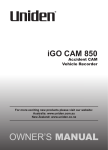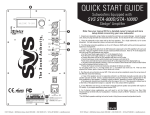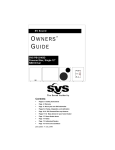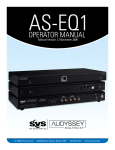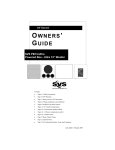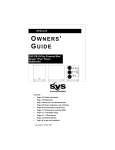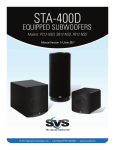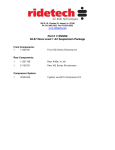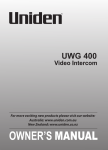Download Owner`s Manual
Transcript
OWNER’S MANUAL SPEAKER SERIES ULTRA TOWER ULTRA BOOKSHELF ULTRA CENTER ULTRA SURROUND Thank you, and congratulations on purchasing your new SVS Ultra Speaker! The SVS Ultra series loudspeakers were designed for audio enthusiasts, by audio enthusiasts with over fifty years combined experience in the high-end audio arena, with a relentless passion for designing a stunning, acoustically impeccable loudspeaker that convincingly conveys the emotion of live music and home theater. The SVS Ultra series delivers a deep, detailed soundstage with incredible resolution, absolute transparency, and amazingly rich and articulated bass, outperforming speakers two and three times their price. If you ever have any questions about your SVS product, or need help setting them up, feel free to contact us directly. www.svsound.com • [email protected] • (877) 626-5623 1 owner’s manual v. 1.1_01282013 TABLE OF CONTENTS SETTING UP YOUR ULTRA SPEAKERS FOOT OPTIONS ACOUSTICS & ROOM PLACEMENT ACOUSTICS ROOM PLACEMENT CONNECTION OPTIONS ULTRA SURROUND WALL MOUNTING SURROUND MODES (DUET) SURROUND MODES (BIPOLE & DIPOLE) CARING FOR YOUR ULTRA SPEAKERS WARRANTY FEATURES & SPECIFICATIONS ULTRA TOWER ULTRA BOOKSHELF ULTRA CENTER ULTRA SURROUND 3 3 4 5 6 7 8 9 10 11 11 12 12 13 14 15 2 SETTING UP YOUR ULTRA SPEAKERS FOOT OPTIONS The Ultra Tower speakers come packaged with two sets of foot support options that allow optimal placement on a variety of floor substrates. The Elastomer Isolation feet that come pre-installed on the Ultra Towers can be removed (unscrew to remove) and replaced with the included Threaded Metal Spike kit. Both sets of feet are threaded to allow easy leveling of the Ultra Towers if they should stand on an uneven surface. Elastomer Isolation Feet Threaded Metal Spikes The Ultra Bookshelf, Ultra Center and Ultra Surround also include stick-on bumper kits that can be attached to the bottom of your speakers to protect them when placed on speaker stands and other surfaces. 3 SETTING UP YOUR ULTRA SPEAKERS ACOUSTICS & ROOM PLACEMENT Front Left/Right Loudspeaker Placement and Room Acoustics: Proper placement of the front left/right speakers is essential to achieve the smoothest frequency response, optimal stereo imaging and the most spacious, three-dimensional soundstage. Stereo imaging and soundstage are affected by loudspeaker location and the listening position, relative to each other and room boundaries. Moving the loudspeakers away from room boundaries will tend to improve stereo imaging and spaciousness by attenuating and delaying boundary reflections, thus optimizing direct sound and helping to preserve spatial information in the recording. The amount of exposed glass, drywall and bare flooring in the room will increase the amount of reflected sound and exacerbate problems like slap echo and ringing. Conversely, furnishings like carpeting, drapes and upholstered furniture will reduce the amount of reflected sound in the room. The ratio of direct-to-reflected sound and the decay characteristics of the listening environment will have a large influence on the ultimate sound quality of any loudspeaker system. Dedicated room treatments like absorbers, diffusers and bass traps can greatly improve the sound quality of any listening environment, and are encouraged to extract the absolute best performance from any high-end loudspeaker system. SVS recommends starting with the front loudspeakers located 30-degrees to the left and right (i.e., a 60-degree total window) of the listening position. Toeing-in the loudspeakers 5-10 degrees can often improve imaging, however this is also a function of the distance from nearby boundaries and the ratio of direct-to-reflected sound, so experimentation with toe-in is recommended to obtain optimal results. The location of the front loudspeakers relative to nearby boundaries will excite various room modes (a complex pattern of standing waves with associated peaks and nulls), which will affect the bass response of the loudspeakers. Generally, placing the loudspeakers closer to room boundaries (particularly corners) will increase the bass response. Conversely, moving the loudspeakers away from boundaries and corners will reduce the bass response. Due to the complex interaction of the loudspeakers with nearby boundaries/corners and your listening position, significant changes to the bass response can occur with very small changes in either loudspeaker location or listening position, so experimentation with both placement and listening position is recommended to obtain optimal results. A smaller tightly-enclosed listening room with a Ultra Tower Port Tuning high amount of 'room gain' (a naturally rising low-end response) may cause an excessively strong bass response from the Ultra Tower model, regardless of its placement location in the room. If this occurs, insert the included foam Port Open port plugs into the port opening of each Ultra Tower (see diagram). To obtain a good seal, insert the foam port plug slightly below flush of the port flare. Inserting the foam port plug creates a low-Q sealed acoustic alignment, and results in an earlier roll-off of the bass response. This will often be a better complement to the Port Sealed acoustics of a smaller tightly-enclosed listening environment, resulting in a more balanced and natural-sounding bass response. 4 SETTING UP YOUR ULTRA SPEAKERS ACOUSTICS (cont’d) A note about Ultra Tower phase and A/V receiver auto-setup processes. AUTO EQ - START MIC INPUT The Ultra Tower side-firing woofer array is designed to provide a more accurate in-room bass response than a conventional front-firing tower by uniformly loading the room, thereby reducing amplitude variations caused by room modes. Since the woofers are side-firing, the bass at the listening position is a combination of direct and reflected sound waves. This may result in a phase warning during the A/V receiver auto-setup process. If a phase warning is encountered, it does not necessarily mean there is a problem with the Ultra Tower speaker setup. While moving the Ultra Tower slightly closer or farther away from nearby wall boundaries may clear the phase warning, doing so is not required to obtain optimal bass performance, and the phase warning may be safely disregarded if the loudspeakers are already located in the preferred room location. As a matter of good practice, any time a phase warning is encountered, the polarity of the wiring at the loudspeaker and amplifier should be doublechecked and corrected as needed. 5 SETTING UP YOUR ULTRA SPEAKERS ROOM PLACEMENT (cont’d) Center Channel Placement The center channel should be equidistant between the main speakers, and directly under the video display. To the extent possible, try to match the tweeter height of the center channel with the tweeter height of the main left/right speakers. Avoid placing the center channel too close to the ceiling or floor, as this will cause boundary reflections and degrade the sound quality. Surround Speakers Placement recommendations will vary depending on the specific channel in question and also the overall surround sound configuration. Below are some general height guidelines and also lateral placement diagrams for various surround sound configurations. Side and Rear surround speakers should be placed 2-3 feet above head level when seated. For more assistance on surround setups greater than 7.0, contact our Sound Experts at www.svsound.com or (877) 626-5623. 0° 30° 90° 110° 22° 0° 22° 30° 30° 22° 30° 90° 90° 90° 110° 110° DUET MODE SURROUND TYPICAL STEREO OR 5.0 SPEAKER PLACEMENT 22° 110° 135° 150° 150° 135° DUET MODE SURROUND TYPICAL 7.0 SPEAKER PLACEMENT 6 SETTING UP YOUR ULTRA SPEAKERS CONNECTION OPTIONS Conventional Wiring All Ultra Speakers ship ready for conventional wiring. With the jumper straps in place, attach each Ultra Speaker to a separate amp channel from your receiver/power amplifier. POWER AMPLIFIER TO RIGHT SPEAKER SPEAKER LEVEL OUTPUTS Bi-amping To Bi-amp any of the Ultra Speakers, first remove the jumper straps that come pre-installed on the terminals. With straps removed each pair of binding posts can be attached to SEPARATE amp channels of your receiver/power amplifier. 7 POWER AMPLIFIER SPEAKER LEVEL OUTPUTS TO RIGHT SPEAKER Bi-wiring To Bi-wire any of the Ultra Speakers, first remove the jumper straps that come pre-installed on the terminals. With straps removed each pair of binding posts can be attached to THE SAME amp channel of your receiver/power amplifier. POWER AMPLIFIERS SPEAKER LEVEL OUTPUTS SPEAKER LEVEL OUTPUTS SPEAKER WIRE - GAUGE/LENGTH RECOMMENDATIONS 18 gauge (AWG) < 10ft 16 gauge (AWG) < 25ft. 14 gauge (AWG) < 50ft. 12 gauge (AWG) < 75ft. SETTING UP YOUR ULTRA SPEAKERS SPEAKER MOUNTING Ultra Surround: Select a location on your wall to mount the Ultra Surrounds. We recommend a height of 24-36 inches about ear level at the listening position. Locate the Ultra Surround bracket kit and mount the smaller of the two brackets to the back of the Ultra Surround with the supplied hardware. The bracket channel should be pointing downward. 24”-36” The larger bracket can be mounted to your wall. Attach the included rubber bumper levelers To hang the Ultra Surround, lift the speaker just above the bracket that was attached to the wall. Carefully move the speaker in towards the wall and lower it until the two brackets engage each other. 8 SETTING UP YOUR ULTRA SURROUND SURROUND MODES Duet Mode - Duet mode is a unique configuration which allows a single Ultra Surround speaker to be used as two independent speakers. This means you can use just two (2) Ultra Surround speakers, and still have four (4) discrete side/rear surround channels for a true 7.1 surround setup. Duet mode is recommended for all home theater systems which have a 7.1 A/V receiver and use one (1) pair of surround speakers. Bipole Mode - In bipole mode, both sets of speakers are in phase, which provides a more localized and directional surround sound effect. Bipole mode is recommended for home theater systems which have a 7.1 A/V receiver and use dedicated side surround and rear surround speakers. Dipole Mode - In dipole mode, both sets of speakers are out of phase, which provides a more diffuse and non-directional surround sound effect. Dipole mode is recommended for home theater systems which have a legacy 5.1 A/V receiver and use one (1) pair of surround speakers which are mounted directly to the sides of the listening position. For Duet mode, perform the following steps: • Remove the jumper straps as shown in the below diagram. • For the right side surround, connect the amplifier wires to the lower (Duet 2) binding posts. • For the right rear surround, connect the amplifier wires to the upper (Duet 1) binding posts. • For the left side surround, connect the amplifier wires to the upper (Duet 1) binding posts. • For the left rear surround, connect the amplifier wires to the lower (Duet 2) binding posts. 1 1 2 2 SIDE SURROUND CHANNELS Remove Straps 9 REAR SURROUND CHANNELS SETTING UP YOUR ULTRA SURROUND SURROUND MODES (cont’d) Bipole Mode Bipole mode is the factory default configuration. For bipole configuration, perform the following steps: • Attach the jumper straps as shown in the below diagram. • Connect the amplifier wires to the lower (Duet 2) binding posts. Straps must be attached Dipole Mode For dipole configuration, perform the following steps: • Remove the jumper straps (failure to do so could damage the amplifier). • Install the dipole wiring kit as shown in the below diagram. • For the right surround channel, connect the amplifier wires to the lower (Duet 2) binding posts. • For the left surround channel, connect the amplifier wires to the upper (Duet 1) binding posts. LEFT Surround (connect to upper binding posts) Remove Straps DIPOLE CABLE KIT RIGHT Surround (connect to lower binding posts) Remove Straps 10 CARING FOR YOUR ULTRA SPEAKERS Your Ultra Speakers may be gently cleaned as follows: • Use a dry microfiber duster to remove any loose surface dust. • Use a water-damp microfiber cloth to remove fingerprints, smudges and other contaminants. Wipe in one direction only, and for wood finishes wipe with the grain. • Follow any damp cleaning immediately with a dry microfiber cloth. Again dry wipe in one direction only, and for wood finishes dry in the direction of the grain. • For piano gloss finishes, consult a furniture restoration professional to remove any micro-scratches, swirl marks and drinking glass rings. 5-YEAR UNCONDITIONAL WARRANTY SVS offers the industry's most comprehensive warranty on all our products. SVS warrants these Ultra Speakers and all of its products to be free from defects in the workmanship for 5 years from date of purchase. This, and all of the SVS customer Bill of Rights can be viewed online at www.svsound.com/bill-of-rights. 11 ULTRA SPEAKER FEATURES & SPECIFICATIONS ALL SPECIFICATIONS ARE SUBJECT TO CHANGE. SVS IS CONSTANTLY WORKING TO IMPROVE OUR PRODUCTS AND GIVE YOU, THE CUSTOMER, THE BEST LISTENING EXPERIENCE FROM YOUR PURCHASE. ULTRA TOWER Frequency Response and Electro-Acoustic Data: • Rated bandwidth: 28 Hz-32 kHz (± 3 dB). • Nominal impedance: 8 ohms. • Sensitivity: 88 dB (2.83V @ 1 meter full-space, 300-3kHz). • Recommended amplifier power: 20-300 watts Loudspeaker Physical Description: • Dimensions (HxWxD): 45" x 13.8" x 16.25", 114.3 x 35 x 41.3 cm. • Weight: 75.4 lbs., 34.2 kgs. • Dual gold-plated 5-way binding posts. • 3.5” wide-flared rear-firing port. • Cloth grille with pin/cup retention system. Driver Array and Technical Highlights: • 1" tweeter features FEA-optimized diffuser and aluminum dome. • 6.5" midrange driver features composite glass-fiber cone, aluminum shorting ring, cast aluminum basket and vented voice coil former. • 8" woofer features aluminum shorting rings, long stroke motor and suspension and a vented voice coil former. ForceFactor Woofer Array: • Dual 8" side-firing horizontally opposed UltraSonic woofers results in mechanical force cancellation, enhanced modal density and reduced distortion for a smooth, accurate bass at all listening locations. SoundMatch Crossover Network: • 3.5-way crossover with premium-grade capacitors, air-core inductors and heavy-trace printed circuit boards. • Unique tapered midrange array minimizes off-axis lobing and enhances radiated sound power into listening space. • Top midrange-to-tweeter crossover: 2 kHz. • Bottom midrange taper frequency: 950 Hz. • Dual midrange-to-woofer crossover: 160 Hz. Cabinet Construction Technical Highlights: • Separate sealed midrange enclosures minimize top-to-bottom wall dimensions and shift standing waves beyond the driver pass band, minimizing negative driver interaction and associated frequency response degradation. • Non-parallel cabinet panels reduces axial standing waves within the cabinet, reducing frequency response coloration. • Acoustically transparent and FEA optimized grilles, wedge-shaped front baffle and flush-mounted drivers all contribute to reduced edge diffraction and improved on-axis high frequency response. 12 ULTRA SPEAKER FEATURES & SPECIFICATIONS ULTRA BOOKSHELF Frequency Response and Electro-Acoustic Data: • Rated bandwidth: 45 Hz-32 kHz (± 3 dB). • Nominal impedance: 8 ohms. • Sensitivity: 87 dB (2.83V @ 1 meter full-space, 300-3kHz). • Recommended amplifier power: 20-150 watts Loudspeaker Physical Description: • Dimensions (HxWxD): 14.9" x 8.5" x 10", 37.8 x 21.6 x 25.4 cm. • Weight: 19 lbs., 8.6 kgs. • Dual gold-plated 5-way binding posts. • 1.7” rear-firing port. • Cloth grille with pin/cup retention system. Driver Array and Technical Highlights: • 1" tweeter features FEA-optimized diffuser and aluminum dome. • 6.5" woofer features composite glass-fiber cone, aluminum shorting ring, cast aluminum basket and vented voice coil former. SoundMatch Crossover Network: • 2-way crossover with premium-grade capacitors, air-core inductors and heavy-trace printed circuit boards. • Crossover frequency and slopes optimized for excellent off-axis polar response, outstanding phase coherency, and total radiated sound power. • Tweeter-to-woofer crossover: 2 kHz. Cabinet Construction Technical Highlights: • Precision CNC-manufactured cabinet with extensive internal blocking and bracing, resulting in no resonances and excellent rigidity. • Acoustically transparent and FEA optimized grilles, wedge-shaped front baffle and flush-mounted drivers all contribute to reduced edge diffraction and improved on-axis high frequency response. 13 ULTRA SPEAKER FEATURES & SPECIFICATIONS ULTRA CENTER Frequency Response and Electro-Acoustic Data: • Rated bandwidth: 45 Hz-32 kHz (± 3 dB). • Nominal impedance: 8 ohms. • Sensitivity: 87 dB (2.83V @ 1 meter full-space, 300-3kHz). • Recommended amplifier power: 20-225 watts Loudspeaker Physical Description: • Dimensions (HxWxD): 8" x 22" x 10", 20.3 x 55.9 x 25.4cm • Weight: 31 lbs., 14.1 kgs. • Dual gold-plated 5-way binding posts. • Dual 1.7” rear-firing ports. • Cloth grille with pin/cup retention system. Driver Array and Technical Highlights: • Vertically aligned tweeter and midrange improves horizontal axis polar response, with reduced lobing and comb filtering. • 1" tweeter features FEA-optimized diffuser and aluminum dome. • 4" midrange driver and 6.5" woofer features composite glass-fiber cone, aluminum shorting ring, cast aluminum basket and vented voice coil former. SoundMatch Crossover Network: • 3-way crossover with premium-grade capacitors, air-core inductors and heavy-trace printed circuit boards. • Midrange-to-tweeter crossover: 2 kHz. • Midrange-to-woofer crossover: 500 Hz. Cabinet Construction Technical Highlights: • Precision CNC-manufactured cabinet with extensive internal blocking and bracing, resulting in no resonances and excellent rigidity. • Acoustically transparent and FEA optimized grilles, wedge-shaped front baffle and flush-mounted drivers all contribute to reduced edge diffraction and improved on-axis high frequency response. 14 ULTRA SPEAKER FEATURES & SPECIFICATIONS ULTRA SURROUND Frequency Response and Electro-Acoustic Data: • Rated bandwidth: 58 Hz-32 kHz (± 3 dB). • Nominal impedance: 8 ohms. • Sensitivity: 87 dB (2.83V @ 1 meter full-space, 300-3kHz). • Recommended amplifier power: 20-250 watts Loudspeaker Physical Description: • Dual Baffle Surround Loudspeaker • Dimensions (HxWxD): 14" x 12.3" x 5.4", 35.6 x 31.2 x 13.7 cm. • Weight: 18 lbs., 8.1 kgs. • Dual independent gold-plated 5-way binding posts. • Cloth grille with pin/cup retention system. • Aluminum wall mounting bracket with safety catch feature to help prevent inadvertent removal. Driver Array and Technical Highlights: • 1" tweeter features FEA-optimized diffuser and aluminum dome. • 5.25" woofer features composite glass-fiber cone, aluminum shorting ring, cast aluminum basket and vented voice coil former. Unique Surround Sound Operating Modes: • Bipole mode (both sets of drivers in phase). • Dipole mode (both set of drivers out of phase). • Duet mode (each set of drivers receives a discrete signal, creating two separate speakers within one cabinet). • Duet mode allows true 7-channel surround sound with just one pair of surround speakers. SoundMatch Crossover Network: • 2-way crossover with premium-grade capacitors, air-core inductors and heavy-trace printed circuit boards. • Dual isolated crossover networks allows for bipole, dipole or unique Duet mode. • Crossover frequency and slopes optimized for outstanding total radiated sound power. • Tweeter-to-woofer crossover: 2 kHz. Cabinet Construction Technical Highlights: • Non-parallel cabinet panels reduces axial standing waves within the cabinet, reducing frequency response coloration. • Acoustically transparent and FEA optimized grilles, wedge-shaped front baffle and flush-mounted drivers all contribute to reduced edge diffraction and improved on-axis high frequency response. 15 SVS 6420 Belmont Ave. Girard, Ohio 44420 United States (877) 626-5623 www.svsound.com

















